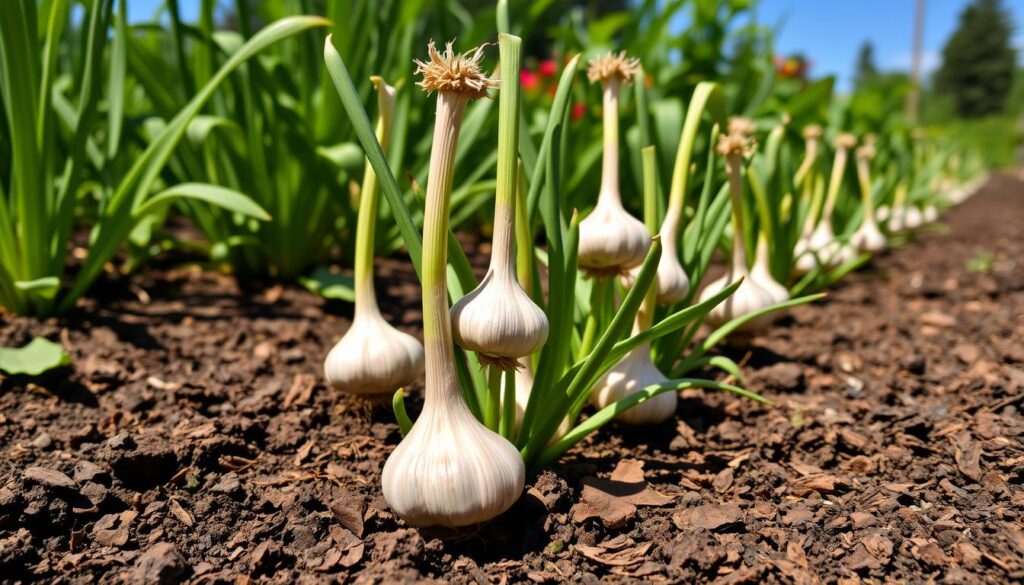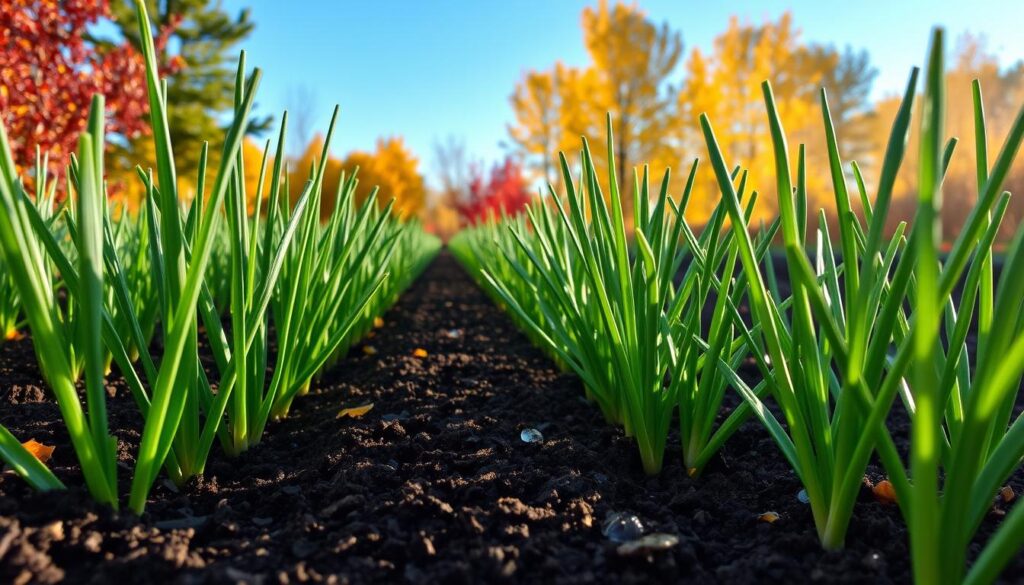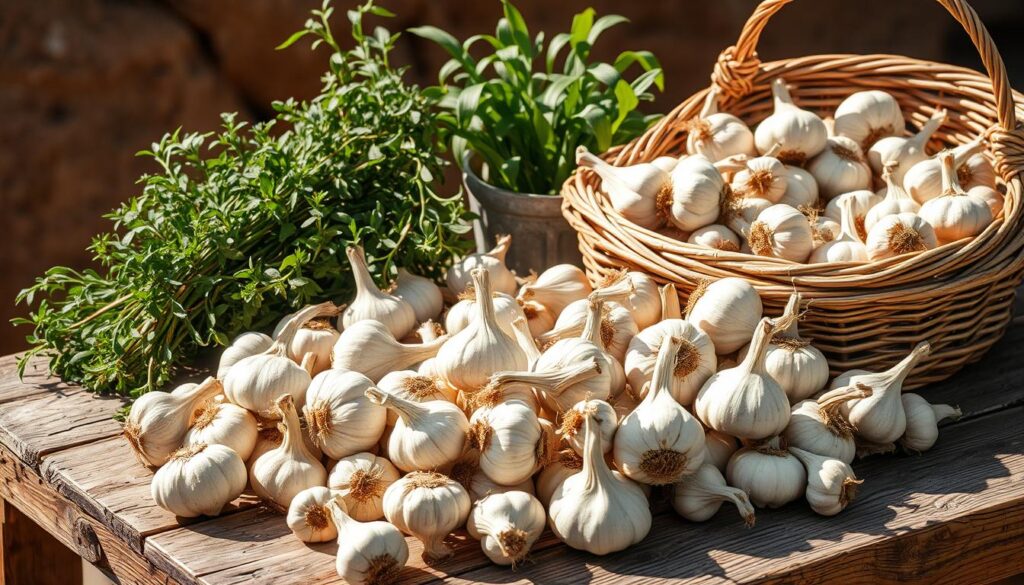Many gardeners wonder When To Plant Garlic in Minnesota. The ideal time is in the fall, about 6-8 weeks before the ground freezes. This allows the cloves to settle into the soil over winter. To start growing garlic in Minnesota, pick a spot with full sun and well-drained soil. Add compost or well-rotted manure to the soil to prepare it.
Garlic thrives in soil that holds moisture but drains well, with a pH of 6.0 to 7.0. Planting cloves in the fall, after the first frost, is best. This lets them grow in the soil all winter and sprout in spring. Knowing when and how to plant garlic in Minnesota is key to a good harvest.
Learning to grow garlic in Minnesota takes planning and care. By using the right methods, gardeners can enjoy a rich harvest of tasty garlic.
Table of Contents
Understanding Garlic Varieties for Minnesota
When planting garlic in MN, picking the right type is key. Garlic comes in two main types: hardneck and softneck. Hardneck garlic is better for Minnesota’s cold because it’s more winter-hardy and has bigger cloves. Softneck garlic is for warmer places but can grow well in Minnesota with the right care.
It’s important to know the differences between hardneck and softneck garlic. Hardneck garlic has fewer but larger cloves, making it more flavorful. For Minnesota, ‘Rocambole’ and ‘Purple Stripe’ are good hardneck choices. ‘Silverskin’ and ‘Artichoke’ are better softneck options.
Soil quality, moisture, and temperature also affect garlic growth. To help garlic grow well, it needs the right conditions. This means planting in a sunny spot with soil that’s at least 8 inches deep.
- Hardneck garlic varieties are more winter-hardy and produce larger cloves
- Softneck garlic varieties are better suited for warmer climates, but can also grow in Minnesota with proper care
- Soil quality, moisture, and temperature can influence garlic growth
- Garlic should be planted in a location that receives at least 8 hours of sunlight daily
- Soil should be cultivated to a depth of at least 8 inches for optimal growth
By knowing the different garlic types and their traits, Minnesota gardeners can choose wisely. With the right variety and care, growing garlic in MN can be both rewarding and tasty.
Ideal Planting Seasons in Minnesota
Understanding the best times to plant garlic in Minnesota is key. To figure out when to plant garlic in Minnesota, you need to know the state’s climate and the garlic type. Fall is usually the best time, about 6-8 weeks before the ground freezes. This lets the cloves grow in the soil over winter and sprout in spring.
If you want to plant in spring, pick a garlic type made for it. Make sure it gets enough water and nutrients. The secret to growing garlic well in Minnesota is planting at the right time and caring for it. In Central Minnesota, the best time is after the first hard frost, around Halloween.
Fall Planting: Timing Guidelines
Fall planting is the most common way to grow garlic in Minnesota. Plant garlic cloves two inches deep and six inches apart. Also, leave enough space between rows for weeding and harvesting.
Spring Planting: What You Need to Know
Spring planting can work, but it needs careful planning. Choose a spring garlic type and give it enough water and nutrients. Don’t add nitrogen after May 1 to avoid harming growth.
Soil Preparation for Garlic Planting
Soil preparation is key when planting garlic in MN. The University of Minnesota suggests using well-drained, moisture-retentive soil. The ideal pH range is between 6.0 and 7.0. Testing the soil pH is a must before planting.
Soil pH can be tested with a kit or by sending a sample to a lab. If the pH is off, lime or sulfur can adjust it. Adding compost or well-rotted manure boosts soil fertility and structure, helping garlic grow well in MN.
Some important soil preparation tips include:
- Soil pH: 6.0-7.0
- Soil type: Well-drained, moisture-retentive
- Organic matter: Add compost or well-rotted manure to improve soil fertility and structure
By following these steps, gardeners can create the perfect soil for garlic in MN. This ensures a successful harvest.
| Soil Characteristic | Recommended Value |
|---|---|
| pH | 6.0-7.0 |
| Organic Matter | Compost or well-rotted manure |
Choosing the Right Location for Garlic
Choosing the right spot is key when growing garlic in Minnesota. Garlic needs full sun, so pick a place that gets at least 6 hours of direct sunlight daily. The soil should also drain well to avoid waterlogged conditions, which can cause disease and stunted growth. The University of Minnesota notes that good air circulation is also important for healthy growth.
When planting garlic in MN, keep these points in mind:
- Sunlight: Garlic needs full sun to grow well, so choose a location that receives direct sunlight for at least 6 hours a day.
- Drainage: Well-drained soil is essential to prevent waterlogged soil and reduce the risk of disease.
- Air circulation: Good air circulation can help prevent disease and promote healthy growth.
By considering these factors, you can create an ideal environment for your garlic. With the right location and proper care, you can enjoy a successful harvest. You’ll learn how to grow garlic in Minnesota like a pro.

Planting Techniques for Garlic
Planting garlic in Minnesota needs careful timing. The best time is in the fall, 6-8 weeks before the ground freezes. This lets the garlic grow strong roots before winter. Check your area’s climate to find out when to plant garlic in Minnesota.
In Northern Minnesota, plant in late September. Southern Minnesota is best in early October.
Before planting, prepare the soil and plant the garlic cloves right. The University of Minnesota suggests planting cloves 2-3 inches deep and 4-6 inches apart. Make sure the pointed end is up for better growth. Choose healthy, disease-free cloves to grow garlic in Minnesota.
- Plant garlic cloves 6 inches apart in rows that are 1.5 feet apart.
- Use a layer of mulch, such as leaves, to insulate the soil and retain moisture.
- Water the garlic regularly, but avoid overwatering, which can lead to disease.
| Garlic Variety | Cloves per Bulb | Shelf Life |
|---|---|---|
| Hardneck | 4-12 | 6-8 months |
| Softneck | 8-14 | 9-12 months |
By following these tips, you can grow garlic in Minnesota and enjoy a great harvest.
Watering Garlic for Healthy Growth
Watering is key when growing garlic in MN. Garlic needs about 1 inch of water each week, from rain or irrigation. This is vital during spring, when plants grow leaves and bulbs.
To keep plants watered right, aim for steady moisture but don’t overdo it. Too much water can cause yellow leaves, soft bulbs, and disease. Regularly check soil moisture and adjust watering to avoid these problems.
For MN garlic growers, remember the crop’s needs. Garlic is ready to harvest in July. From mid-May to June, water every three to five days.

Here are some watering tips for garlic:
* Water deeply but not too often to encourage strong roots.
* Skip overhead watering to prevent disease.
* Use soaker hoses or drip irrigation to water roots directly.
Following these tips and a regular watering schedule will help your garlic grow well and yield a good harvest.
| Watering Frequency | Watering Depth |
|---|---|
| Every 3-5 days during bulbing phase | 1 inch per week |
| Every 7-10 days during vegetative growth | 0.5-1 inch per week |
Fertilization Tips for Garlic
When growing garlic in Minnesota, fertilization is key for healthy growth and high yields. The University of Minnesota says garlic needs lots of nutrients. A balanced fertilizer with a 10-10-10 (N-P-K) ratio works well.
For planting garlic in MN, apply fertilizer when the garlic is 6 inches tall in spring. This gives it the nutrients it needs for growth and yield. Good fertilizers for garlic include:
- Organic fertilizers like fish emulsion
- Bone meal and seabird guano for phosphorus
- Compost or fish meal to enhance garlic flavor and bulb formation
Choosing the right fertilizer and timing is also important. Garlic needs full sun from late winter for best growth. By following these tips, Minnesota gardeners can grow healthy garlic and get great yields.
| Fertilizer Type | Application Timing | Benefits |
|---|---|---|
| Organic fertilizers | Spring, when garlic is 6 inches tall | Promotes healthy growth, maximizes yields |
| Bone meal and seabird guano | Spring, when garlic is 6 inches tall | Provides phosphorus for root development |
| Compost or fish meal | Fall, before planting | Enhances garlic flavor and bulb formation |
Pest and Disease Management for Garlic
Growing garlic in MN means watching out for pests and diseases. The University of Minnesota says onion maggot and bulb mites are big problems. These pests can really hurt your garlic crop, making it smaller and less good.
To keep pests and diseases away, you need a good plan. This includes rotating crops, keeping things clean, and choosing strong varieties. Also, check your garlic often to catch any problems early.
Garlic in Minnesota can get sick with white rot, fusarium basal rot, and botrytis neck rot. These diseases can ruin your crop if you don’t stop them. Knowing how to prevent them helps a lot. Use clean garlic, keep things tidy, and grow it right.
By being careful and knowing what to watch for, you can grow great garlic in MN. Whether you’re growing it for yourself or to sell, keeping pests and diseases under control is key to success.
| Disease | Cause | Symptoms | Prevention |
|---|---|---|---|
| White Rot | Fungal infection | Yellowing leaves, white growth on bulbs | Use clean seed garlic, practice good sanitation |
| Fusarium Basal Rot | Fungal infection | Soft, rotting tissue at base of plant | Use resistant varieties, provide optimal growing conditions |
| Botrytis Neck Rot | Fungal infection | Soft, rotting tissue on neck of plant | Provide good air circulation, avoid excessive moisture |
Harvesting Garlic: Timing is Key
Garlic is ready to harvest when the tops of the plants start to yellow and fall over. This usually happens in mid-to-late July, about 3-4 months after planting in Minnesota. Knowing when to plant garlic in Minnesota and how to grow garlic in Minnesota is important. The quality and flavor of the bulbs can be affected by the timing of the harvest.
To check if the garlic is ready, look for these signs:
- The tops of the plants have started to yellow and fall over.
- Two bottom leaves are completely dead, and a third is beginning to die.
- The rate of bulb growth has slowed down, indicating that the garlic is mature.
When the garlic is ready, it’s important to harvest it carefully. Gently loosen the soil around the bulbs with a fork. Then, lift the bulbs out of the ground. Handle the garlic bulbs carefully to avoid bruising or damaging them.
After harvesting, the garlic needs to be cured. This removes excess moisture and prepares it for storage. Dry the garlic in a cool, well-ventilated area. Keep temperatures between 55°F-65°F and relative humidity below 60%. Proper curing and storage will help maintain the quality and flavor of the garlic. This makes it a successful crop for those learning how to grow garlic in Minnesota.
| Garlic Variety | Harvest Time | Curing Method |
|---|---|---|
| Hardneck | Mid-July | Drying racks or hanging bunches |
| Softneck | Late July | Drying racks or hanging bunches |
Curing and Storing Garlic After Harvest
After you harvest garlic, it’s key to cure the bulbs. This step removes extra moisture and helps keep them fresh longer. When growing garlic in MN, using the right curing and storage methods is vital. The University of Minnesota advises drying garlic in a warm, dry, well-ventilated spot.
For the best results, cure garlic for 3 to 4 weeks in a cool, dark spot. This drying process lowers the chance of mold and spoilage. When planting garlic in MN, remember that different varieties have unique storage needs. Some, like hardneck garlic, need extra care to avoid damage.

To store garlic, keep it in a cool, dry area with good air flow. A basement or pantry works well, as long as it’s not too humid. By following these tips, you can enjoy your garlic for months, whether you’re growing garlic in MN or planting garlic in MN.
Frequently Asked Questions
How Late Can You Plant Garlic in Minnesota?
In Minnesota, the latest time to plant garlic is typically late October to early November, about 1–2 weeks before the ground freezes. This allows the cloves to establish roots before winter. If planted too late, they may not root properly, leading to weaker plants in the spring.
What Type of Garlic Grows Best in Minnesota?
Hardneck garlic varieties grow best in Minnesota because they handle cold winters well. Popular types include German White, Music, and Chesnok Red. These varieties develop strong roots in the fall and produce flavorful bulbs in the summer. Softneck garlic, commonly found in grocery stores, does not perform as well in Minnesota’s harsh winters.
What Not to Do When Planting Garlic?
Avoid planting grocery store garlic, as it may be treated to prevent sprouting and may not be suited to Minnesota’s climate. Also, don’t plant in poorly drained soil—garlic needs loose, well-draining soil to prevent rot. Other mistakes include planting cloves too deep or too shallow and not giving enough space between them.
Why Do You Soak Garlic Before Planting?
Soaking garlic before planting is optional but can help prevent disease and pests. Some gardeners soak cloves in a mixture of water and baking soda for a few hours before planting to reduce fungal issues. Others use a seaweed solution to promote strong root growth.
Can You Plant Garlic in June?
No, planting garlic in June is too late in Minnesota. Garlic needs a cold period to develop properly, so fall planting is best. If planted in spring, bulbs will likely be small or underdeveloped.
Do You Water Garlic Right After Planting?
Yes, watering after planting helps settle the soil and encourages root development. Keep the soil moist but not soggy, and mulch with straw to retain moisture and protect the cloves over winter.

